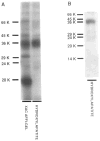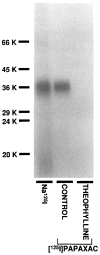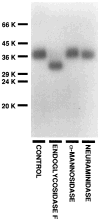Purification and characterization of bovine cerebral cortex A1 adenosine receptor
- PMID: 2275555
- PMCID: PMC3476062
- DOI: 10.1016/0003-9861(90)90665-l
Purification and characterization of bovine cerebral cortex A1 adenosine receptor
Abstract
A1 adenosine receptors (A1AR) acting via the inhibitory guanine nucleotide binding protein inhibit adenylate cyclase activity in brain, cardiac, and adipose tissue. We now report the purification of the A1AR from bovine cerebral cortex. This A1AR is distinct from other A1ARs in that it displays an agonist potency series of N6-R-phenylisopropyladenosine (R-PIA) greater than N6-S-phenylisopropyladenosine greater than (S-PIA) greater than 5'-N-ethylcarboxamidoadenosine (NECA) compared to the traditional potency series of R-PIA greater than NECA greater than S-PIA. The A1AR was solubilized in 1% 3-[(3-cholamidopropyl)dimethylammonio]-1-propanesulfonate (Chaps) and then purified by chromatography on an antagonist [xanthine amine congener (XAC)]-coupled Affi-Gel 10 followed by hydroxylapatite chromatography. Following purification, sodium dodecyl sulfate-polyacrylamide gel electrophoresis revealed a single protein of Mr 36,000 by silver staining, Na125I iodination with chloramine T and photoaffinity labeling with [125I]8-[4-[[[[2-(4-aminophenyl acetylamino) ethyl] carbonyl] methyl] oxy]-phenyl]-1,3- dipropylxanthine. This single protein displayed all the characteristics of the A1AR, including binding an antagonist radioligand [( 3H]XAC) with high affinity (Kd = 0.7 nM) and in a saturable manner (Bmax greater than 4500 pmol/mg). Agonist competition curves demonstrated the expected bovine brain A1AR pharmacology: R-PIA greater than S-PIA greater than NECA. The overall yield from soluble preparation was 7%. The glycoprotein nature of the purified A1AR was determined with endo- and exoglycosidases. Deglycosylation with endoglycosidase F increased the mobility of the A1AR from Mr 36,000 to Mr 32,000 in a single step. The A1AR was sensitive to neuraminidase but resistant to alpha-mannosidase, suggesting the single carbohydrate chain was of the complex type. This makes the bovine brain A1AR similar to rat brain and fat A1AR in terms of its carbohydrate chains yet the purified A1AR retains its unique agonist potency series observed in membranes.
Figures




Similar articles
-
Demonstration of both A1 and A2 adenosine receptors in DDT1 MF-2 smooth muscle cells.Mol Pharmacol. 1990 Feb;37(2):149-56. Mol Pharmacol. 1990. PMID: 2304450 Free PMC article.
-
Affinity chromatography of the bovine cerebral cortex A1 adenosine receptor.FEBS Lett. 1989 Nov 6;257(2):292-6. doi: 10.1016/0014-5793(89)81555-8. FEBS Lett. 1989. PMID: 2583275 Free PMC article.
-
Co-purification of A1 adenosine receptors and guanine nucleotide-binding proteins from bovine brain.J Biol Chem. 1989 Sep 5;264(25):14853-9. J Biol Chem. 1989. PMID: 2504712
-
A new high affinity, iodinated adenosine receptor antagonist as a radioligand/photoaffinity crosslinking probe.Mol Pharmacol. 1987 Aug;32(1):184-8. Mol Pharmacol. 1987. PMID: 3614192 Free PMC article.
-
A1 adenosine receptor inhibition of cyclic AMP formation and radioligand binding in the guinea-pig cerebral cortex.Br J Pharmacol. 1994 Dec;113(4):1501-7. doi: 10.1111/j.1476-5381.1994.tb17166.x. Br J Pharmacol. 1994. PMID: 7889308 Free PMC article.
Cited by
-
Characterization of adenosine receptor in its native environment: insights from molecular dynamics simulations of palmitoylated/glycosylated, membrane-integrated human A(2B) adenosine receptor.J Mol Model. 2012 Sep;18(9):4309-24. doi: 10.1007/s00894-012-1427-y. Epub 2012 May 9. J Mol Model. 2012. PMID: 22570080
-
The A2 adenosine receptor: guanine nucleotide modulation of agonist binding is enhanced by proteolysis.Mol Pharmacol. 1991 Feb;39(2):130-5. Mol Pharmacol. 1991. PMID: 1899902 Free PMC article.
-
Solubilized rabbit striatal A2a-adenosine receptors: stability and antagonist binding.Arch Biochem Biophys. 1993 Sep;305(2):611-7. doi: 10.1006/abbi.1993.1469. Arch Biochem Biophys. 1993. PMID: 8373201 Free PMC article.
-
Functionalized congener approach to the design of ligands for G protein-coupled receptors (GPCRs).Bioconjug Chem. 2009 Oct 21;20(10):1816-35. doi: 10.1021/bc9000596. Epub 2009 Apr 30. Bioconjug Chem. 2009. PMID: 19405524 Free PMC article. Review.
-
TRIFUNCTIONAL LIGANDS: A RADIOIODINATED HIGH AFFINITY ACYLATING ANTAGONIST FOR THE A1 ADENOSINE RECEPTOR.Pharmacol Commun. 1992;1(2):145-154. Pharmacol Commun. 1992. PMID: 25374448 Free PMC article.
References
-
- Ramkumar V, Pierson G, Stiles G. Progress in Drug Research. Vol. 32. Birkhauser; Cambridge, MA: 1988. pp. 195–247. - PubMed
-
- Bailey J, Ravdon D. Basic and Clinical Aspects. A. R. Liss, Inc; New York: 1987. Clinical Electrophysiology and Pharmacology of Adenosine and ATP; pp. 119–133.
-
- Kurtz A. J Biol Chem. 1987;262:6296–6300. - PubMed
Publication types
MeSH terms
Substances
Grants and funding
LinkOut - more resources
Full Text Sources
Other Literature Sources

